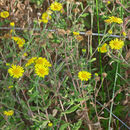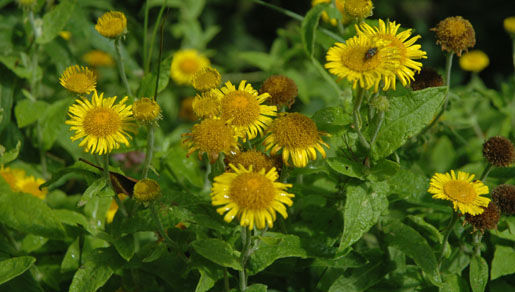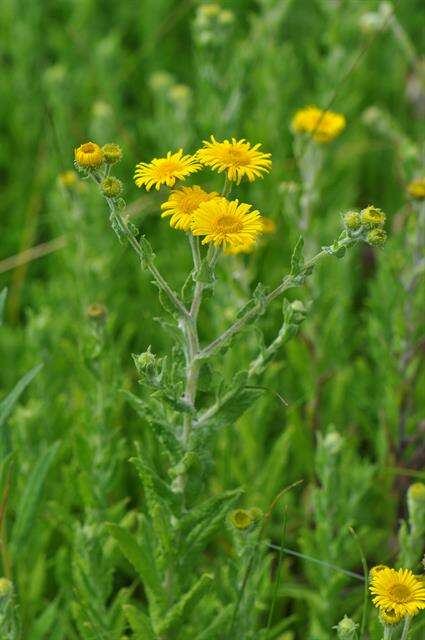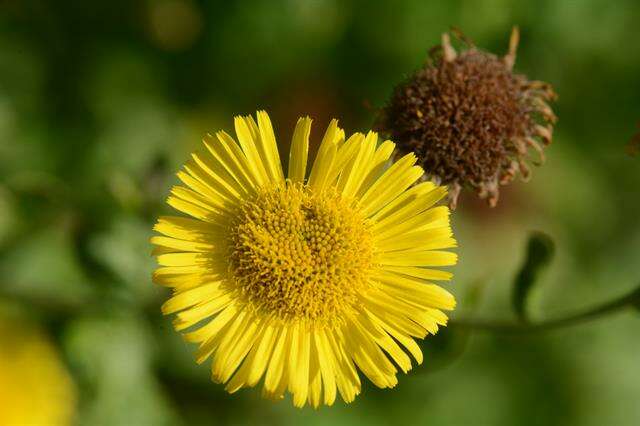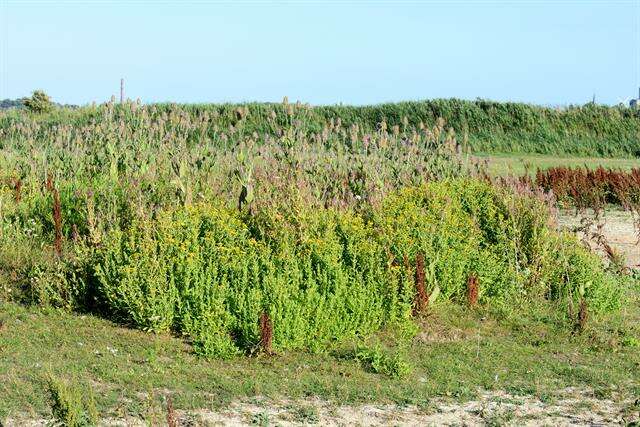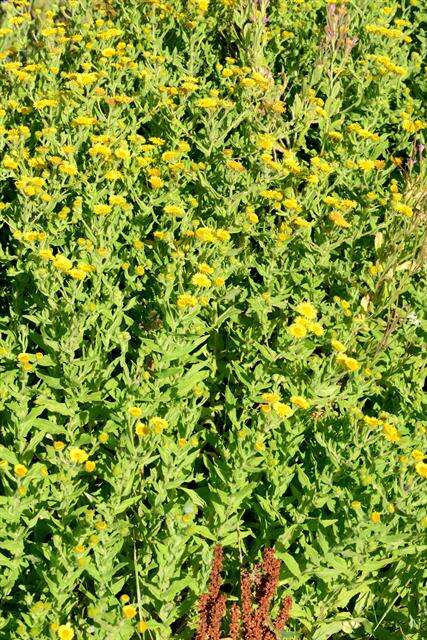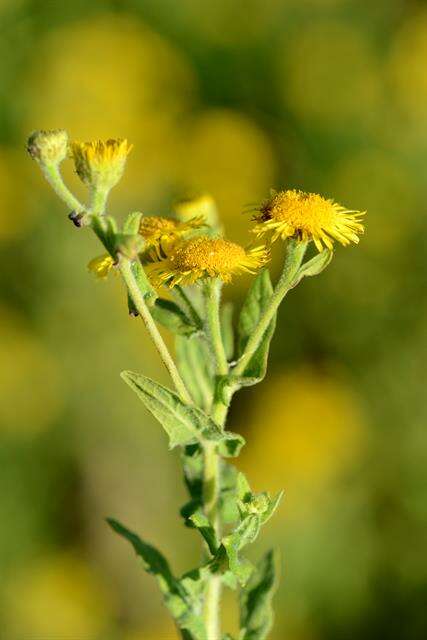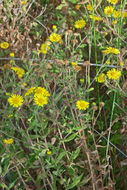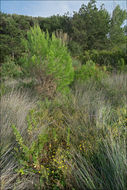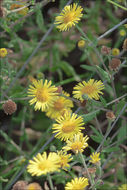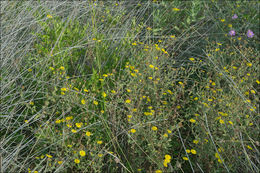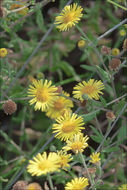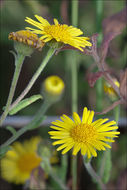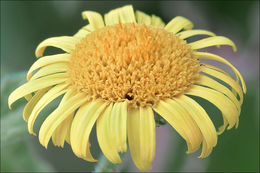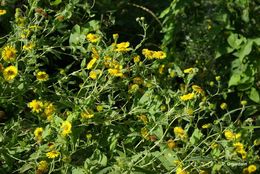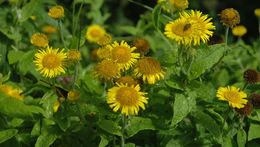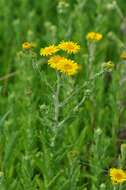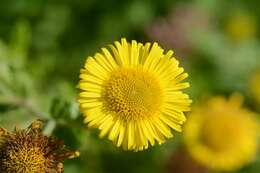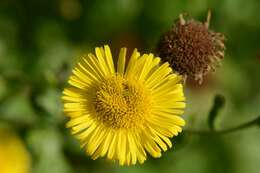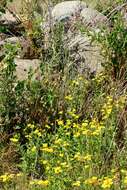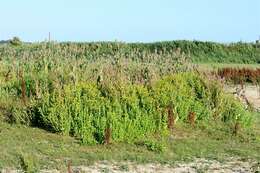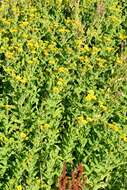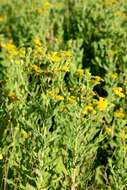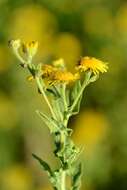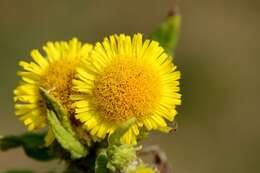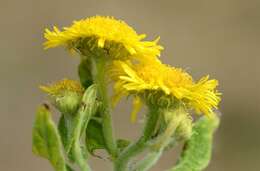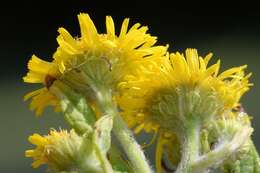-
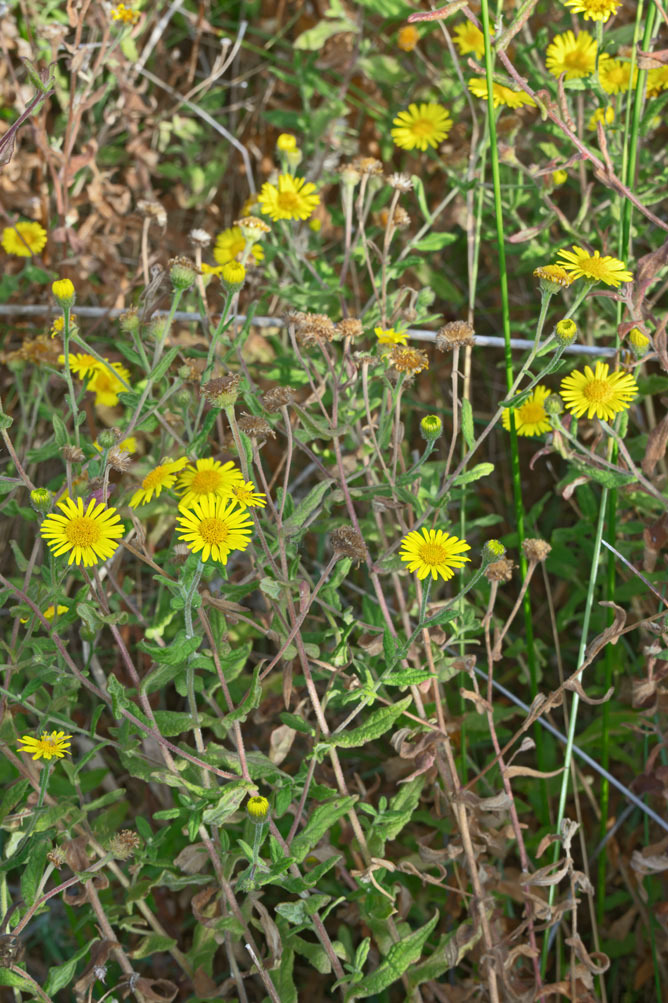
Slo.: barska bolhaa, srastolistna bolhaa - syn.: Pulicaria dysenterica (L.) Bernh., Pulicaria uliginosa Stev. ex DC., Inula repens Trevir, Inula dysenterica L. - Habitat: Flat sandy bay, sandstone bedrock; among other tall herbs in a dense thicket; flat terrain, moist place; full sun; about 30 m from sea shore; elevation 2 m (7 feet); average precipitations ~1000 mm/year, average temperature 13-14 deg C, (Sub)Mediterranean phytogeographical region. Substratum: sandy soil.Comment: Pulicaria dysenterica subsp. uliginosa is a Mediterranean plant and not really a showy one. Many would call it a weed. It is one of many yellow flowered members of the daisy family (Asteraceae = Compositae), which are not always easy to separate to genus and species level. Yet, the genus Pulicaria has a unique trait, which is very characteristic. Its achenes (small, dry fruits) have double pappus (this is the modified calyx, the part of an individual floret that surrounds the base of the corolla tube in flower heads). It consists of inner circle of many long and thin hairs and an outer circle in shape of a small silver, toothed 'crown' of closely fused scales. Of cause, to observe this filigree structure one has to disassemble a flower head and observe individual flowers in it. A good magnifying glass is obvious.Pulicaria dysenterica is a Mediterranean plant, however, very widely distributed also outside of its home. It has to be very variable plant since its taxonomy is not understood uniquely by experts. Hence, there is also some confusion in plant naming. The subspecies name Pulicaria dysenterica subsp. uliginosa is not univocally recognized (although Euro-Med Plant Base, Ref.6 considers this name as 'Preliminary Accepted'). Some experts call it Pulicaria uliginosa, others Pulicaria dysenterica. Even in a single country there are disagreements. For example in Flora Croatica Data Base (Ref. 7) neither Pulicaria dysenterica subsp. uliginosa nor Pulicaria uliginosa exist. On the other hand, Croatian national key (Ref. 5) clearly distinguish Pulicaria uliginosa as a separate species. Following this key the plant found could be named Pulicaria uliginosa. Small flower heads, 1 - 1.5(2) cm in diameter (2 - 3 cm for alternative Pulicaria dysenterica), and typical habitus with almost horizontal side branches seem decisive. Apparently the name Pulicaria dysenterica subsp. uliginosa has a wider acceptance than Pulicaria uliginosa so I decided for it.Ref. (1) A. Martini et all., Mala Flora Slovenije (Flora of Slovenia - Key) (in Slovenian), Tehnina Zaloba Slovenije (2007), p 652. (2) http://luirig.altervista.org/flora/taxa/index1.php?scientific-name=pulicaria+dysenterica+subsp.+uliginosa (accessed Oct. 15. 2017)(3) D. Aeschimann, K. Lauber, D.M. Moser, J.P. Theurillat, Flora Alpina, Vol. 2., Haupt (2004), p 462.(4) I. Schnfelder, P. Schnfelder, Kosmos Atlas Mittelmeer- und Kanarenflora, Kosmos, (2002), p 218.(5) R. Domac, Flora Hrvatske (Flora of Croatia, Key) (in Croatian), kolska Knjiga, Zagreb (1994), p 346.(6 ) http://ww2.bgbm.org/EuroPlusMed/PTaxonDetail.asp?NameId=129515&PTRefFk=7000000 (accessed Oct. 15. 2017)(7) http://hirc.botanic.hr/fcd/DetaljiFrame.aspx?IdVrste=8168&taxon=Pulicaria+dysenterica+(L.)+Bernh. (accessed Oct. 15. 2017)
-
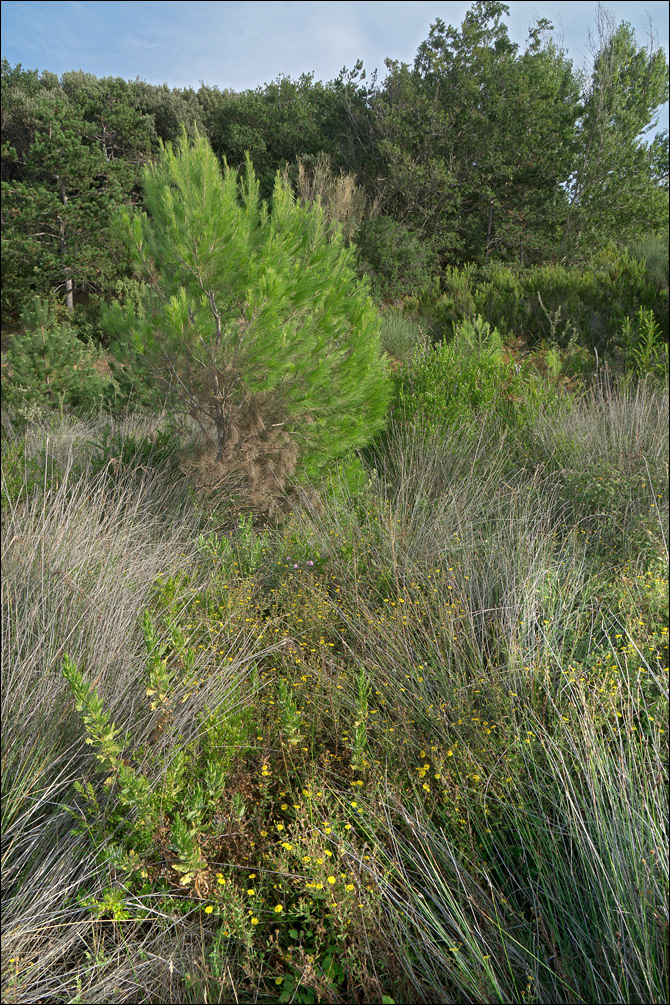
Slo.: barska bolhaa, srastolistna bolhaa - syn.: Pulicaria dysenterica (L.) Bernh., Pulicaria uliginosa Stev. ex DC., Inula repens Trevir, Inula dysenterica L. - Habitat: Flat sandy bay, sandstone bedrock; among other tall herbs in a dense thicket; flat terrain, moist place; full sun; about 30 m from sea shore; elevation 2 m (7 feet); average precipitations ~1000 mm/year, average temperature 13-14 deg C, (Sub)Mediterranean phytogeographical region. Substratum: sandy soil. Comment: Pulicaria dysenterica subsp. uliginosa is a Mediterranean plant and not really a showy one. Many would call it a weed. It is one of many yellow flowered members of the daisy family (Asteraceae = Compositae), which are not always easy to separate to genus and species level. Yet, the genus Pulicaria has a unique trait, which is very characteristic. Its achenes (small, dry fruits) have double pappus (this is the modified calyx, the part of an individual floret that surrounds the base of the corolla tube in flower heads). It consists of inner circle of many long and thin hairs and an outer circle in shape of a small silver, toothed 'crown' of closely fused scales. Of cause, to observe this filigree structure one has to disassemble a flower head and observe individual flowers in it. A good magnifying glass is obvious. Pulicaria dysenterica is a Mediterranean plant, however, very widely distributed also outside of its home. It has to be very variable plant since its taxonomy is not understood uniquely by experts. Hence, there is also some confusion in plant naming. The subspecies name Pulicaria dysenterica subsp. uliginosa is not univocally recognized (although Euro-Med Plant Base, Ref.6 considers this name as 'Preliminary Accepted'). Some experts call it Pulicaria uliginosa, others Pulicaria dysenterica. Even in a single country there are disagreements. For example in Flora Croatica Data Base (Ref. 7) neither Pulicaria dysenterica subsp. uliginosa nor Pulicaria uliginosa exist. On the other hand, Croatian national key (Ref. 5) clearly distinguish Pulicaria uliginosa as a separate species. Following this key the plant found could be named Pulicaria uliginosa. Small flower heads, 1 - 1.5(2) cm in diameter (2 - 3 cm for alternative Pulicaria dysenterica), and typical habitus with almost horizontal side branches seem decisive. Apparently the name Pulicaria dysenterica subsp. uliginosa has a wider acceptance than Pulicaria uliginosa so I decided for it. Ref. (1) A. Martini et all., Mala Flora Slovenije (Flora of Slovenia - Key) (in Slovenian), Tehnina Zaloba Slovenije (2007), p 652. (2) http://luirig.altervista.org/flora/taxa/index1.php?scientific-name=pulicaria+dysenterica+subsp.+uliginosa (accessed Oct. 15. 2017) (3) D. Aeschimann, K. Lauber, D.M. Moser, J.P. Theurillat, Flora Alpina, Vol. 2., Haupt (2004), p 462. (4) I. Schnfelder, P. Schnfelder, Kosmos Atlas Mittelmeer- und Kanarenflora, Kosmos, (2002), p 218. (5) R. Domac, Flora Hrvatske (Flora of Croatia, Key) (in Croatian), kolska Knjiga, Zagreb (1994), p 346. (6 ) http://ww2.bgbm.org/EuroPlusMed/PTaxonDetail.asp?NameId=129515&PTRefFk=7000000 (accessed Oct. 15. 2017) (7) http://hirc.botanic.hr/fcd/DetaljiFrame.aspx?IdVrste=8168&taxon=Pulicaria+dysenterica+(L.)+Bernh. (accessed Oct. 15. 2017)
-
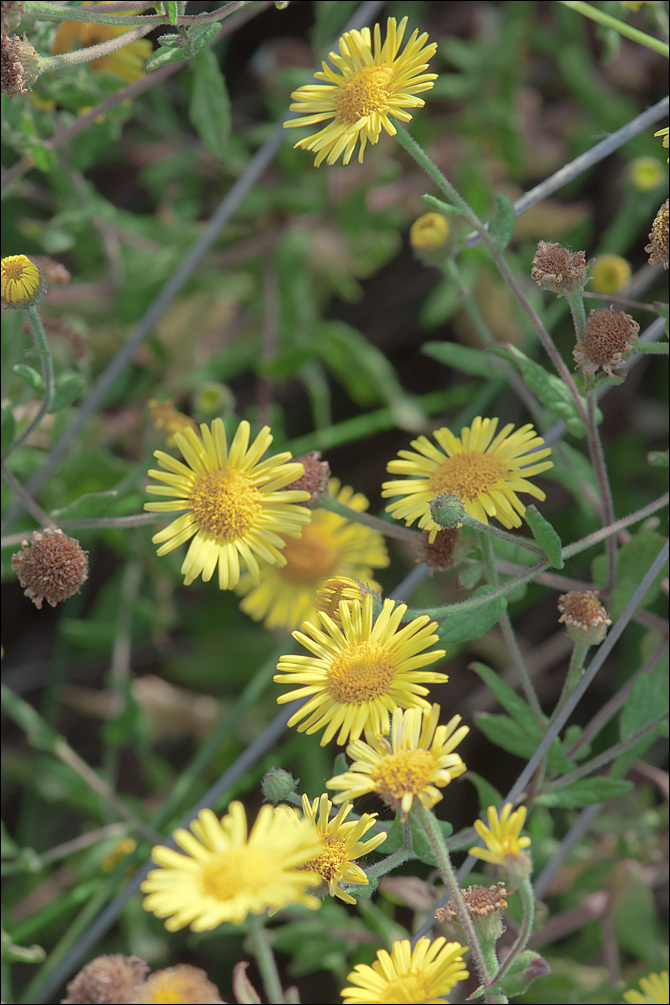
Slo.: barska bolhaa, srastolistna bolhaa - syn.: Pulicaria dysenterica (L.) Bernh., Pulicaria uliginosa Stev. ex DC., Inula repens Trevir, Inula dysenterica L. - Habitat: Flat sandy bay, sandstone bedrock; among other tall herbs in a dense thicket; flat terrain, moist place; full sun; about 30 m from sea shore; elevation 2 m (7 feet); average precipitations ~1000 mm/year, average temperature 13-14 deg C, (Sub)Mediterranean phytogeographical region. Substratum: sandy soil. Comment: Pulicaria dysenterica subsp. uliginosa is a Mediterranean plant and not really a showy one. Many would call it a weed. It is one of many yellow flowered members of the daisy family (Asteraceae = Compositae), which are not always easy to separate to genus and species level. Yet, the genus Pulicaria has a unique trait, which is very characteristic. Its achenes (small, dry fruits) have double pappus (this is the modified calyx, the part of an individual floret that surrounds the base of the corolla tube in flower heads). It consists of inner circle of many long and thin hairs and an outer circle in shape of a small silver, toothed 'crown' of closely fused scales. Of cause, to observe this filigree structure one has to disassemble a flower head and observe individual flowers in it. A good magnifying glass is obvious. Pulicaria dysenterica is a Mediterranean plant, however, very widely distributed also outside of its home. It has to be very variable plant since its taxonomy is not understood uniquely by experts. Hence, there is also some confusion in plant naming. The subspecies name Pulicaria dysenterica subsp. uliginosa is not univocally recognized (although Euro-Med Plant Base, Ref.6 considers this name as 'Preliminary Accepted'). Some experts call it Pulicaria uliginosa, others Pulicaria dysenterica. Even in a single country there are disagreements. For example in Flora Croatica Data Base (Ref. 7) neither Pulicaria dysenterica subsp. uliginosa nor Pulicaria uliginosa exist. On the other hand, Croatian national key (Ref. 5) clearly distinguish Pulicaria uliginosa as a separate species. Following this key the plant found could be named Pulicaria uliginosa. Small flower heads, 1 - 1.5(2) cm in diameter (2 - 3 cm for alternative Pulicaria dysenterica), and typical habitus with almost horizontal side branches seem decisive. Apparently the name Pulicaria dysenterica subsp. uliginosa has a wider acceptance than Pulicaria uliginosa so I decided for it. Ref. (1) A. Martini et all., Mala Flora Slovenije (Flora of Slovenia - Key) (in Slovenian), Tehnina Zaloba Slovenije (2007), p 652. (2) http://luirig.altervista.org/flora/taxa/index1.php?scientific-name=pulicaria+dysenterica+subsp.+uliginosa (accessed Oct. 15. 2017) (3) D. Aeschimann, K. Lauber, D.M. Moser, J.P. Theurillat, Flora Alpina, Vol. 2., Haupt (2004), p 462. (4) I. Schnfelder, P. Schnfelder, Kosmos Atlas Mittelmeer- und Kanarenflora, Kosmos, (2002), p 218. (5) R. Domac, Flora Hrvatske (Flora of Croatia, Key) (in Croatian), kolska Knjiga, Zagreb (1994), p 346. (6 ) http://ww2.bgbm.org/EuroPlusMed/PTaxonDetail.asp?NameId=129515&PTRefFk=7000000 (accessed Oct. 15. 2017) (7) http://hirc.botanic.hr/fcd/DetaljiFrame.aspx?IdVrste=8168&taxon=Pulicaria+dysenterica+(L.)+Bernh. (accessed Oct. 15. 2017)
-
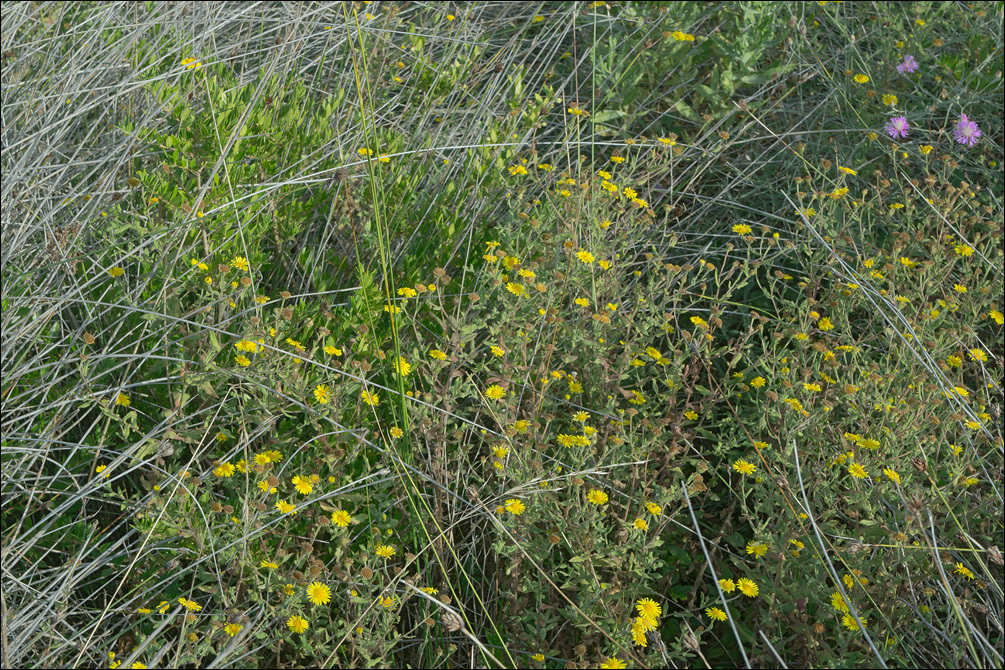
Slo.: barska bolhaa, srastolistna bolhaa - syn.: Pulicaria dysenterica (L.) Bernh., Pulicaria uliginosa Stev. ex DC., Inula repens Trevir, Inula dysenterica L. - Habitat: Flat sandy bay, sandstone bedrock; among other tall herbs in a dense thicket; flat terrain, moist place; full sun; about 30 m from sea shore; elevation 2 m (7 feet); average precipitations ~1000 mm/year, average temperature 13-14 deg C, (Sub)Mediterranean phytogeographical region. Substratum: sandy soil. Comment: Pulicaria dysenterica subsp. uliginosa is a Mediterranean plant and not really a showy one. Many would call it a weed. It is one of many yellow flowered members of the daisy family (Asteraceae = Compositae), which are not always easy to separate to genus and species level. Yet, the genus Pulicaria has a unique trait, which is very characteristic. Its achenes (small, dry fruits) have double pappus (this is the modified calyx, the part of an individual floret that surrounds the base of the corolla tube in flower heads). It consists of inner circle of many long and thin hairs and an outer circle in shape of a small silver, toothed 'crown' of closely fused scales. Of cause, to observe this filigree structure one has to disassemble a flower head and observe individual flowers in it. A good magnifying glass is obvious. Pulicaria dysenterica is a Mediterranean plant, however, very widely distributed also outside of its home. It has to be very variable plant since its taxonomy is not understood uniquely by experts. Hence, there is also some confusion in plant naming. The subspecies name Pulicaria dysenterica subsp. uliginosa is not univocally recognized (although Euro-Med Plant Base, Ref.6 considers this name as 'Preliminary Accepted'). Some experts call it Pulicaria uliginosa, others Pulicaria dysenterica. Even in a single country there are disagreements. For example in Flora Croatica Data Base (Ref. 7) neither Pulicaria dysenterica subsp. uliginosa nor Pulicaria uliginosa exist. On the other hand, Croatian national key (Ref. 5) clearly distinguish Pulicaria uliginosa as a separate species. Following this key the plant found could be named Pulicaria uliginosa. Small flower heads, 1 - 1.5(2) cm in diameter (2 - 3 cm for alternative Pulicaria dysenterica), and typical habitus with almost horizontal side branches seem decisive. Apparently the name Pulicaria dysenterica subsp. uliginosa has a wider acceptance than Pulicaria uliginosa so I decided for it. Ref. (1) A. Martini et all., Mala Flora Slovenije (Flora of Slovenia - Key) (in Slovenian), Tehnina Zaloba Slovenije (2007), p 652. (2) http://luirig.altervista.org/flora/taxa/index1.php?scientific-name=pulicaria+dysenterica+subsp.+uliginosa (accessed Oct. 15. 2017) (3) D. Aeschimann, K. Lauber, D.M. Moser, J.P. Theurillat, Flora Alpina, Vol. 2., Haupt (2004), p 462. (4) I. Schnfelder, P. Schnfelder, Kosmos Atlas Mittelmeer- und Kanarenflora, Kosmos, (2002), p 218. (5) R. Domac, Flora Hrvatske (Flora of Croatia, Key) (in Croatian), kolska Knjiga, Zagreb (1994), p 346. (6 ) http://ww2.bgbm.org/EuroPlusMed/PTaxonDetail.asp?NameId=129515&PTRefFk=7000000 (accessed Oct. 15. 2017) (7) http://hirc.botanic.hr/fcd/DetaljiFrame.aspx?IdVrste=8168&taxon=Pulicaria+dysenterica+(L.)+Bernh. (accessed Oct. 15. 2017)
-
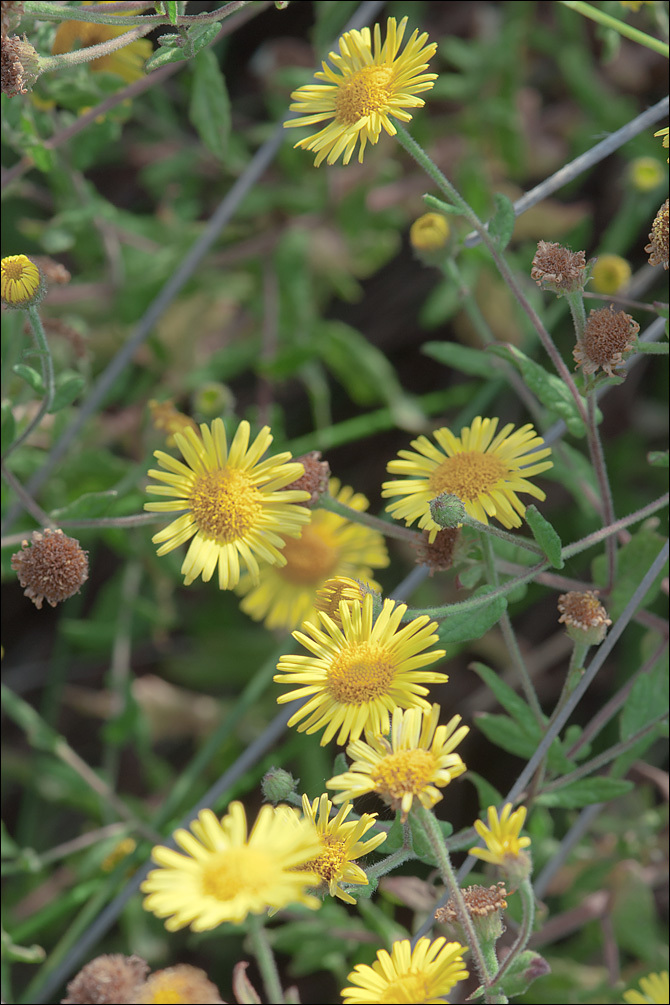
Slo.: barska bolhaa, srastolistna bolhaa - syn.: Pulicaria dysenterica (L.) Bernh., Pulicaria uliginosa Stev. ex DC., Inula repens Trevir, Inula dysenterica L. - Habitat: Flat sandy bay, sandstone bedrock; among other tall herbs in a dense thicket; flat terrain, moist place; full sun; about 30 m from sea shore; elevation 2 m (7 feet); average precipitations ~1000 mm/year, average temperature 13-14 deg C, (Sub)Mediterranean phytogeographical region. Substratum: sandy soil. Comment: Pulicaria dysenterica subsp. uliginosa is a Mediterranean plant and not really a showy one. Many would call it a weed. It is one of many yellow flowered members of the daisy family (Asteraceae = Compositae), which are not always easy to separate to genus and species level. Yet, the genus Pulicaria has a unique trait, which is very characteristic. Its achenes (small, dry fruits) have double pappus (this is the modified calyx, the part of an individual floret that surrounds the base of the corolla tube in flower heads). It consists of inner circle of many long and thin hairs and an outer circle in shape of a small silver, toothed 'crown' of closely fused scales. Of cause, to observe this filigree structure one has to disassemble a flower head and observe individual flowers in it. A good magnifying glass is obvious. Pulicaria dysenterica is a Mediterranean plant, however, very widely distributed also outside of its home. It has to be very variable plant since its taxonomy is not understood uniquely by experts. Hence, there is also some confusion in plant naming. The subspecies name Pulicaria dysenterica subsp. uliginosa is not univocally recognized (although Euro-Med Plant Base, Ref.6 considers this name as 'Preliminary Accepted'). Some experts call it Pulicaria uliginosa, others Pulicaria dysenterica. Even in a single country there are disagreements. For example in Flora Croatica Data Base (Ref. 7) neither Pulicaria dysenterica subsp. uliginosa nor Pulicaria uliginosa exist. On the other hand, Croatian national key (Ref. 5) clearly distinguish Pulicaria uliginosa as a separate species. Following this key the plant found could be named Pulicaria uliginosa. Small flower heads, 1 - 1.5(2) cm in diameter (2 - 3 cm for alternative Pulicaria dysenterica), and typical habitus with almost horizontal side branches seem decisive. Apparently the name Pulicaria dysenterica subsp. uliginosa has a wider acceptance than Pulicaria uliginosa so I decided for it. Ref. (1) A. Martini et all., Mala Flora Slovenije (Flora of Slovenia - Key) (in Slovenian), Tehnina Zaloba Slovenije (2007), p 652. (2) http://luirig.altervista.org/flora/taxa/index1.php?scientific-name=pulicaria+dysenterica+subsp.+uliginosa (accessed Oct. 15. 2017) (3) D. Aeschimann, K. Lauber, D.M. Moser, J.P. Theurillat, Flora Alpina, Vol. 2., Haupt (2004), p 462. (4) I. Schnfelder, P. Schnfelder, Kosmos Atlas Mittelmeer- und Kanarenflora, Kosmos, (2002), p 218. (5) R. Domac, Flora Hrvatske (Flora of Croatia, Key) (in Croatian), kolska Knjiga, Zagreb (1994), p 346. (6 ) http://ww2.bgbm.org/EuroPlusMed/PTaxonDetail.asp?NameId=129515&PTRefFk=7000000 (accessed Oct. 15. 2017) (7) http://hirc.botanic.hr/fcd/DetaljiFrame.aspx?IdVrste=8168&taxon=Pulicaria+dysenterica+(L.)+Bernh. (accessed Oct. 15. 2017)
-
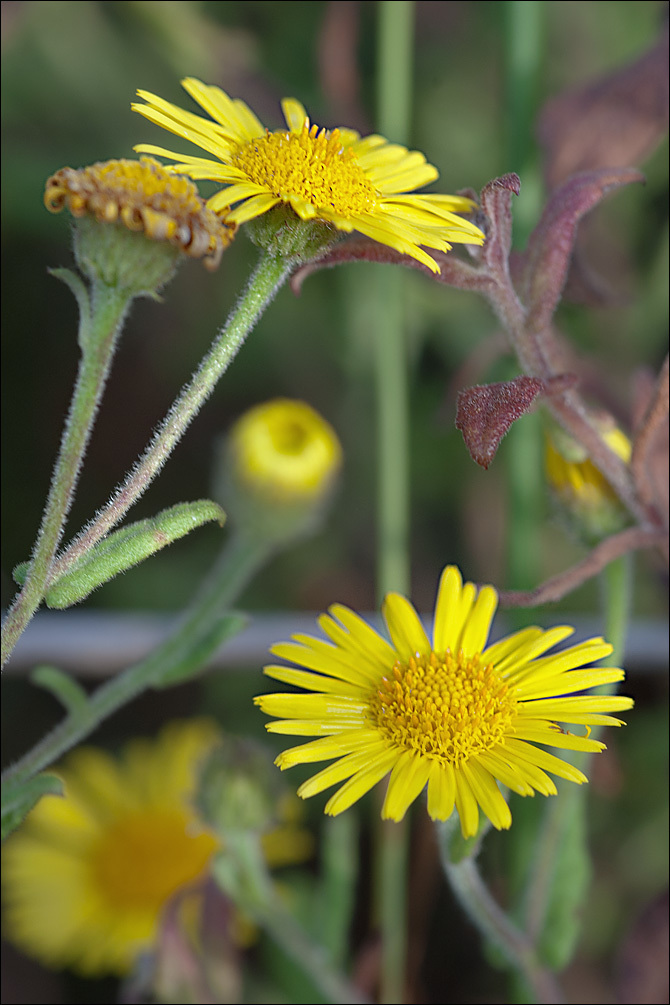
Slo.: barska bolhaa, srastolistna bolhaa - syn.: Pulicaria dysenterica (L.) Bernh., Pulicaria uliginosa Stev. ex DC., Inula repens Trevir, Inula dysenterica L. - Habitat: Flat sandy bay, sandstone bedrock; among other tall herbs in a dense thicket; flat terrain, moist place; full sun; about 30 m from sea shore; elevation 2 m (7 feet); average precipitations ~1000 mm/year, average temperature 13-14 deg C, (Sub)Mediterranean phytogeographical region. Substratum: sandy soil. Comment: Pulicaria dysenterica subsp. uliginosa is a Mediterranean plant and not really a showy one. Many would call it a weed. It is one of many yellow flowered members of the daisy family (Asteraceae = Compositae), which are not always easy to separate to genus and species level. Yet, the genus Pulicaria has a unique trait, which is very characteristic. Its achenes (small, dry fruits) have double pappus (this is the modified calyx, the part of an individual floret that surrounds the base of the corolla tube in flower heads). It consists of inner circle of many long and thin hairs and an outer circle in shape of a small silver, toothed 'crown' of closely fused scales. Of cause, to observe this filigree structure one has to disassemble a flower head and observe individual flowers in it. A good magnifying glass is obvious. Pulicaria dysenterica is a Mediterranean plant, however, very widely distributed also outside of its home. It has to be very variable plant since its taxonomy is not understood uniquely by experts. Hence, there is also some confusion in plant naming. The subspecies name Pulicaria dysenterica subsp. uliginosa is not univocally recognized (although Euro-Med Plant Base, Ref.6 considers this name as 'Preliminary Accepted'). Some experts call it Pulicaria uliginosa, others Pulicaria dysenterica. Even in a single country there are disagreements. For example in Flora Croatica Data Base (Ref. 7) neither Pulicaria dysenterica subsp. uliginosa nor Pulicaria uliginosa exist. On the other hand, Croatian national key (Ref. 5) clearly distinguish Pulicaria uliginosa as a separate species. Following this key the plant found could be named Pulicaria uliginosa. Small flower heads, 1 - 1.5(2) cm in diameter (2 - 3 cm for alternative Pulicaria dysenterica), and typical habitus with almost horizontal side branches seem decisive. Apparently the name Pulicaria dysenterica subsp. uliginosa has a wider acceptance than Pulicaria uliginosa so I decided for it. Ref. (1) A. Martini et all., Mala Flora Slovenije (Flora of Slovenia - Key) (in Slovenian), Tehnina Zaloba Slovenije (2007), p 652. (2) http://luirig.altervista.org/flora/taxa/index1.php?scientific-name=pulicaria+dysenterica+subsp.+uliginosa (accessed Oct. 15. 2017) (3) D. Aeschimann, K. Lauber, D.M. Moser, J.P. Theurillat, Flora Alpina, Vol. 2., Haupt (2004), p 462. (4) I. Schnfelder, P. Schnfelder, Kosmos Atlas Mittelmeer- und Kanarenflora, Kosmos, (2002), p 218. (5) R. Domac, Flora Hrvatske (Flora of Croatia, Key) (in Croatian), kolska Knjiga, Zagreb (1994), p 346. (6 ) http://ww2.bgbm.org/EuroPlusMed/PTaxonDetail.asp?NameId=129515&PTRefFk=7000000 (accessed Oct. 15. 2017) (7) http://hirc.botanic.hr/fcd/DetaljiFrame.aspx?IdVrste=8168&taxon=Pulicaria+dysenterica+(L.)+Bernh. (accessed Oct. 15. 2017)
-
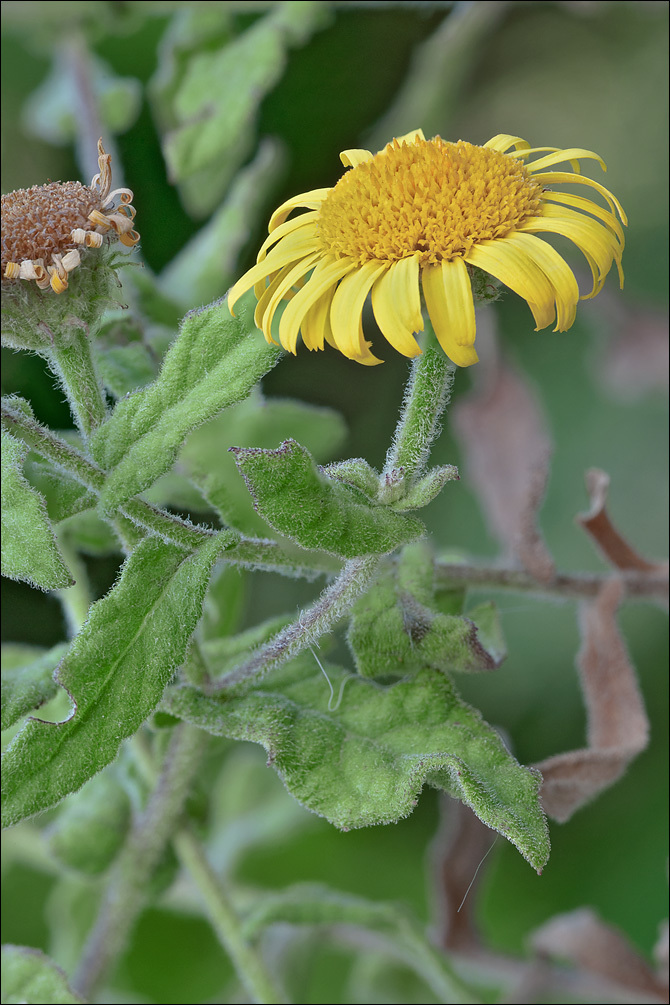
Slo.: barska bolhaa, srastolistna bolhaa - syn.: Pulicaria dysenterica (L.) Bernh., Pulicaria uliginosa Stev. ex DC., Inula repens Trevir, Inula dysenterica L. - Habitat: Flat sandy bay, sandstone bedrock; among other tall herbs in a dense thicket; flat terrain, moist place; full sun; about 30 m from sea shore; elevation 2 m (7 feet); average precipitations ~1000 mm/year, average temperature 13-14 deg C, (Sub)Mediterranean phytogeographical region. Substratum: sandy soil. Comment: Pulicaria dysenterica subsp. uliginosa is a Mediterranean plant and not really a showy one. Many would call it a weed. It is one of many yellow flowered members of the daisy family (Asteraceae = Compositae), which are not always easy to separate to genus and species level. Yet, the genus Pulicaria has a unique trait, which is very characteristic. Its achenes (small, dry fruits) have double pappus (this is the modified calyx, the part of an individual floret that surrounds the base of the corolla tube in flower heads). It consists of inner circle of many long and thin hairs and an outer circle in shape of a small silver, toothed 'crown' of closely fused scales. Of cause, to observe this filigree structure one has to disassemble a flower head and observe individual flowers in it. A good magnifying glass is obvious. Pulicaria dysenterica is a Mediterranean plant, however, very widely distributed also outside of its home. It has to be very variable plant since its taxonomy is not understood uniquely by experts. Hence, there is also some confusion in plant naming. The subspecies name Pulicaria dysenterica subsp. uliginosa is not univocally recognized (although Euro-Med Plant Base, Ref.6 considers this name as 'Preliminary Accepted'). Some experts call it Pulicaria uliginosa, others Pulicaria dysenterica. Even in a single country there are disagreements. For example in Flora Croatica Data Base (Ref. 7) neither Pulicaria dysenterica subsp. uliginosa nor Pulicaria uliginosa exist. On the other hand, Croatian national key (Ref. 5) clearly distinguish Pulicaria uliginosa as a separate species. Following this key the plant found could be named Pulicaria uliginosa. Small flower heads, 1 - 1.5(2) cm in diameter (2 - 3 cm for alternative Pulicaria dysenterica), and typical habitus with almost horizontal side branches seem decisive. Apparently the name Pulicaria dysenterica subsp. uliginosa has a wider acceptance than Pulicaria uliginosa so I decided for it. Ref. (1) A. Martini et all., Mala Flora Slovenije (Flora of Slovenia - Key) (in Slovenian), Tehnina Zaloba Slovenije (2007), p 652. (2) http://luirig.altervista.org/flora/taxa/index1.php?scientific-name=pulicaria+dysenterica+subsp.+uliginosa (accessed Oct. 15. 2017) (3) D. Aeschimann, K. Lauber, D.M. Moser, J.P. Theurillat, Flora Alpina, Vol. 2., Haupt (2004), p 462. (4) I. Schnfelder, P. Schnfelder, Kosmos Atlas Mittelmeer- und Kanarenflora, Kosmos, (2002), p 218. (5) R. Domac, Flora Hrvatske (Flora of Croatia, Key) (in Croatian), kolska Knjiga, Zagreb (1994), p 346. (6 ) http://ww2.bgbm.org/EuroPlusMed/PTaxonDetail.asp?NameId=129515&PTRefFk=7000000 (accessed Oct. 15. 2017) (7) http://hirc.botanic.hr/fcd/DetaljiFrame.aspx?IdVrste=8168&taxon=Pulicaria+dysenterica+(L.)+Bernh. (accessed Oct. 15. 2017)
-
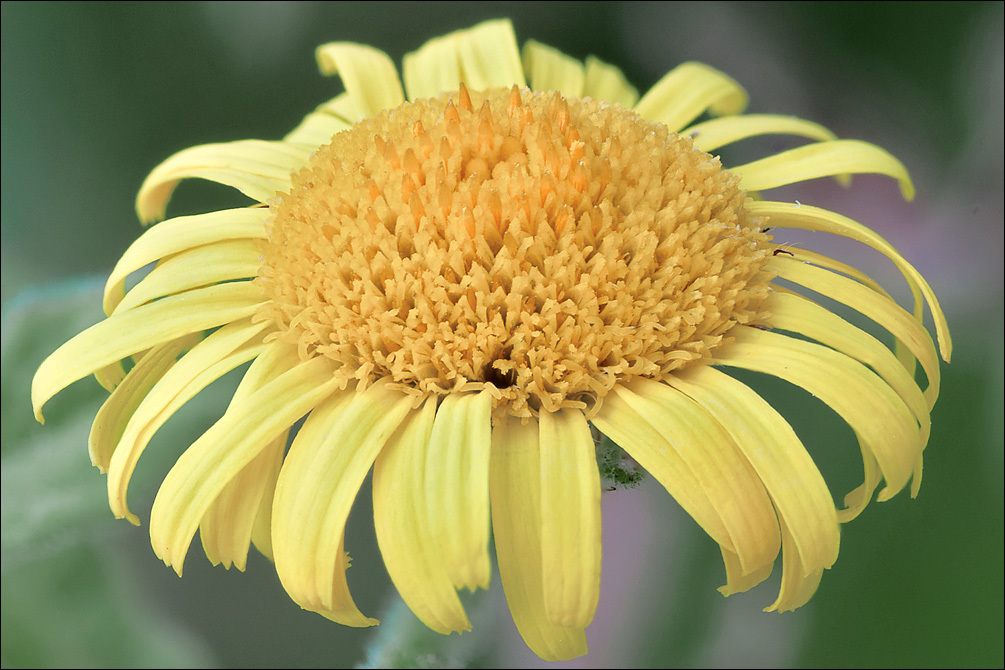
Slo.: barska bolhaa, srastolistna bolhaa - syn.: Pulicaria dysenterica (L.) Bernh., Pulicaria uliginosa Stev. ex DC., Inula repens Trevir, Inula dysenterica L. - Habitat: Flat sandy bay, sandstone bedrock; among other tall herbs in a dense thicket; flat terrain, moist place; full sun; about 30 m from sea shore; elevation 2 m (7 feet); average precipitations ~1000 mm/year, average temperature 13-14 deg C, (Sub)Mediterranean phytogeographical region. Substratum: sandy soil. Comment: Pulicaria dysenterica subsp. uliginosa is a Mediterranean plant and not really a showy one. Many would call it a weed. It is one of many yellow flowered members of the daisy family (Asteraceae = Compositae), which are not always easy to separate to genus and species level. Yet, the genus Pulicaria has a unique trait, which is very characteristic. Its achenes (small, dry fruits) have double pappus (this is the modified calyx, the part of an individual floret that surrounds the base of the corolla tube in flower heads). It consists of inner circle of many long and thin hairs and an outer circle in shape of a small silver, toothed 'crown' of closely fused scales. Of cause, to observe this filigree structure one has to disassemble a flower head and observe individual flowers in it. A good magnifying glass is obvious. Pulicaria dysenterica is a Mediterranean plant, however, very widely distributed also outside of its home. It has to be very variable plant since its taxonomy is not understood uniquely by experts. Hence, there is also some confusion in plant naming. The subspecies name Pulicaria dysenterica subsp. uliginosa is not univocally recognized (although Euro-Med Plant Base, Ref.6 considers this name as 'Preliminary Accepted'). Some experts call it Pulicaria uliginosa, others Pulicaria dysenterica. Even in a single country there are disagreements. For example in Flora Croatica Data Base (Ref. 7) neither Pulicaria dysenterica subsp. uliginosa nor Pulicaria uliginosa exist. On the other hand, Croatian national key (Ref. 5) clearly distinguish Pulicaria uliginosa as a separate species. Following this key the plant found could be named Pulicaria uliginosa. Small flower heads, 1 - 1.5(2) cm in diameter (2 - 3 cm for alternative Pulicaria dysenterica), and typical habitus with almost horizontal side branches seem decisive. Apparently the name Pulicaria dysenterica subsp. uliginosa has a wider acceptance than Pulicaria uliginosa so I decided for it. Ref. (1) A. Martini et all., Mala Flora Slovenije (Flora of Slovenia - Key) (in Slovenian), Tehnina Zaloba Slovenije (2007), p 652. (2) http://luirig.altervista.org/flora/taxa/index1.php?scientific-name=pulicaria+dysenterica+subsp.+uliginosa (accessed Oct. 15. 2017) (3) D. Aeschimann, K. Lauber, D.M. Moser, J.P. Theurillat, Flora Alpina, Vol. 2., Haupt (2004), p 462. (4) I. Schnfelder, P. Schnfelder, Kosmos Atlas Mittelmeer- und Kanarenflora, Kosmos, (2002), p 218. (5) R. Domac, Flora Hrvatske (Flora of Croatia, Key) (in Croatian), kolska Knjiga, Zagreb (1994), p 346. (6 ) http://ww2.bgbm.org/EuroPlusMed/PTaxonDetail.asp?NameId=129515&PTRefFk=7000000 (accessed Oct. 15. 2017) (7) http://hirc.botanic.hr/fcd/DetaljiFrame.aspx?IdVrste=8168&taxon=Pulicaria+dysenterica+(L.)+Bernh. (accessed Oct. 15. 2017)
-
-
-
Common fleabane; Heelblaadje.
-
Botanisk Have Århus
-
Botanisk Have Århus
-
Botanisk Have Århus
-
Siø, Langeland, Danmark
-
Siø, Langeland, Danmark
-
Siø, Langeland, Danmark
-
Siø, Langeland, Danmark
-
Siø, Langeland, Danmark
-
Siø, Langeland, Danmark
-
Siø, Langeland, Danmark
-
Gulstav Klint, Langeland, Danmark
-
Gulstav Klint, Langeland, Danmark
-
Gulstav Klint, Langeland, Danmark

